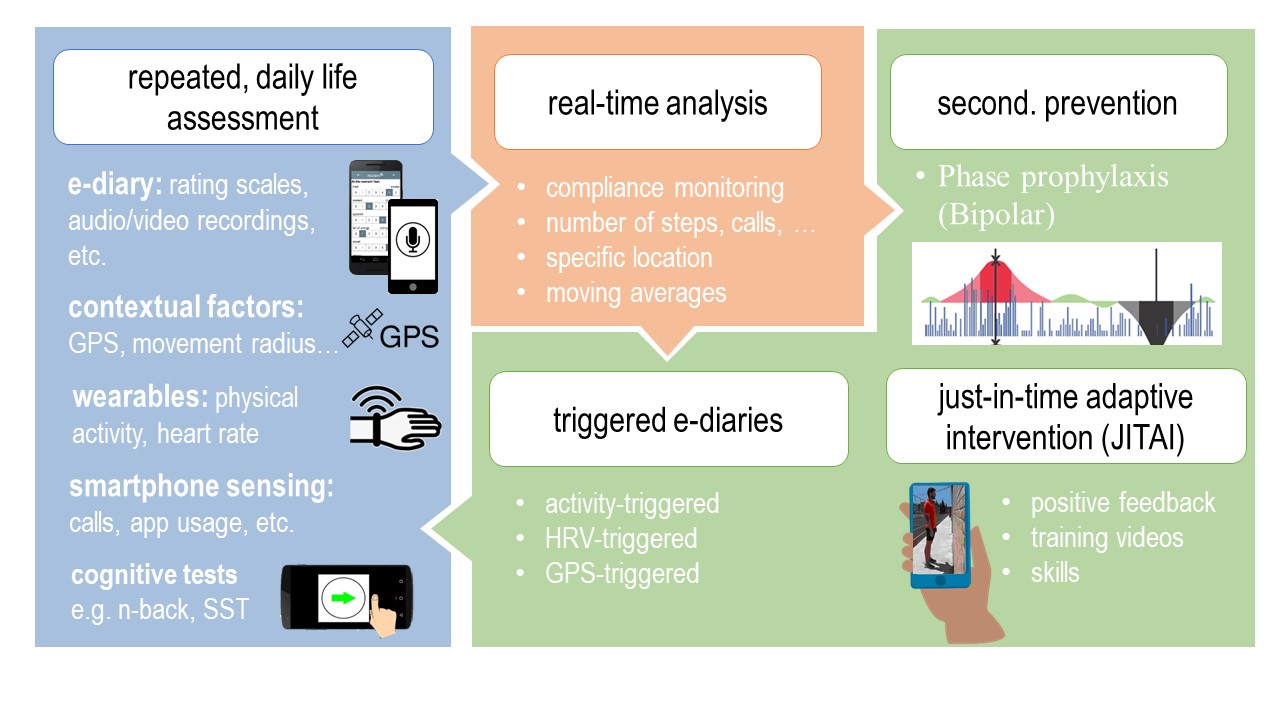Zooming in: examining psychopathology in everyday life
We use smartphones, wearables, and sensors to study psychopathology as it unfolds in patients’ everyday lives. We utilize these devices to examine symptoms and momentary mechanism in a broad range of mental disorders. In our view, using mobile devices while participants go about their daily lives is perfectly complementing research based on laboratory studies and questionnaire studies.
Research projects
Some of our projects
-
Start date
01/12/2016
-
Duration in months
48
-
Funding
German Research Foundation
-
Project Team
Ulrich Ebner-Priemer (Karlsruhe Institute of Technology); Michael Eid (Freie Universität Berlin); Philip Santangelo (Uni.lu); Jana Holtmann (University Leipzig); Tobias Kockler (Karlsruhe Institute of Technology)
-
Partners
Martin Bohus (Central Institute for Mental Health Mannheim)
-
Abstract
In this study, we use high sampling-frequency ambulatory assessment with hourly e-diary assessments to examine disorder mechanisms in the daily life of patients with borderline personality disorder (BPD), those with anxiety disorders, and healthy controls. We are mostly interested in affective instability, self-esteem instability, and the temporal interplay of these two constructs in participants’ daily lives. Our analyses of instability combine proven statistical instability indices with state-of-the-art multilevel models. We primarily aim at revealing BPD-specific patterns of instability and at differentiating them from transdiagnostic mechanisms. Furthermore, we investigate the states leading up to and following instances of dysfunctional behavior, such as nonsuicidal self-injury.
-
Start date
01/11/2017
-
Duration in months
60
-
Funding
Federal Ministry of Education and Research of Germany
-
Project Team
Ulrich Ebner-Priemer (Karlsruhe Institute of Technology); Philip Santangelo (Uni.lu)
-
Partners
Paul L. Plener (Ulm University Hospital); Christian Schmahl (Central Institute of Mental Health in Mannheim); Tina In-Albon (University of Koblenz-Landau); Michael Kaess (Heidelberg University Hospital); Julian Koenig (Heidelberg University Hospital)
-
Abstract
This multi-center study in cooperation with the universities of Heidelberg, Landau/Koblenz, Mannheim, Neuruppin, Rostock, and Ulm combines various research methods such as electronic diaries, laboratory tasks, neuro-imaging, and online therapy. We contribute with an e-diary assessment in the daily lives of adolescents and young adults engaging in non-suicidal self-injuries (NSSI) and healthy controls. This large-scale e-diary study (intended sample size of 300 patients and 150 healthy controls) aims at examining the temporal mechanisms involved in NSSI by using individualized high sampling-frequency e-diary assessments as well as psychophysiological assessments (cortisol, sleep, and activity) over seven days. We thereby tailor the e-diary assessments to each participant’s individual school hours such that no inquiries occur during classes. Our primary focus is to investigate the intraindividual states leading up to and following instances of NSSI, i.e. to address the underlying psychological and physiological mechanisms in order to derive potential therapeutic approaches.
-
Start date
01/04/2016
-
Duration in months
36
-
Funding
KIT funding
-
Project Team
Philip Santangelo (Uni.lu); Sean Lane (University of Missouri)
-
Partners
Christian Parret (Central Institute for Mental Health Mannheim); Christian Schmahl (Central Institute for Mental Health Mannheim)
-
Abstract
Emotion dysregulation is a central feature of borderline personality disorder (BPD). Functional magnetic resonance imaging can be used to implement neurofeedback-based training in emotion regulation. The investigation of the effects of such an intervention is ideally conducted in patients’ everyday lives, i.e. the context, in which the symptoms actually occur. Electronic diaries are ideally suited, as they enable the examination of subjective and objective indices of emotion dysregulation. Thus, we used electronic diaries in this pilot intervention study to examine the effects of the neurofeedback training. Before and after a neurofeedback intervention, 24 patients with BPD carried an electronic diary over four consecutive days with 12 prompts in hourly intervals each. Patients were asked to answer 5 items regarding negative affect and 5 regarding positive affect (thus, a subjective assessment), while the response times for answering the emotion items were recorded. Both response time and momentary intra-class coefficients were used as two objective measures of emotional clarity. We conducted pre-post comparisons of the subjective and objective indices of emotional dysregulation using multilevel models. Both with regard to the subjective (self-assessment of the ability to control one’s own emotions) and objective (reaction time and momentary intra-class coefficients) measures of emotional clarity, results show a significant increase in emotional clarity after the neurofeedback intervention compared to before, indicating an effect of the intervention.
